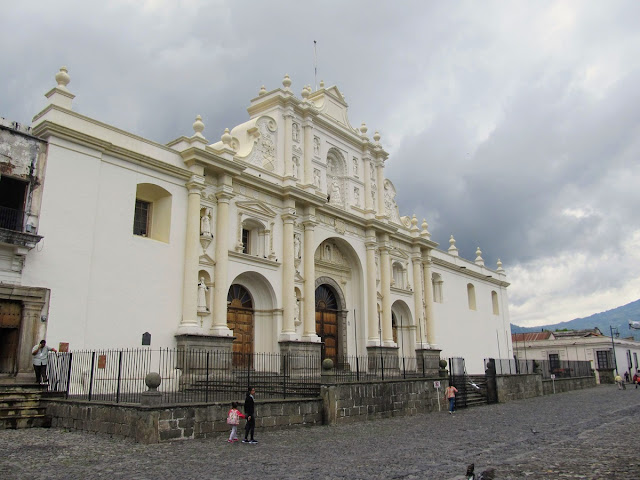Maybe it was the perfect weather or the howler monkeys or the thousands
of butterflies, but Palenque ended up unexpectedly being our favourite
Mayan site on this trip and second overall (after Tikal). It has
probably found the best balance between restoration and jungle setting,
protection and letting you climb/explore, while being large enough to
explore for a couple hours without having to get lost or walk long distances
through areas of no interest. It is touristy but not too crowded also.
Unfortunately we visited on a Monday and the site museum was closed.
Palenque was at it's peak about 1400 years ago and was built in the southern Mayan style (ie. more similar to Calakmul that we would see later, but also Tikal and Copan) and is situated in an elevated location above a plain to take advantage of natural water sources. There are even remnants of an underground water channel that passes beside the central palace and under the plaza. There are quite a few large temples with faded inscriptions inside but nice views over the complex. There were lots of bats in the tunnels under the central palace too but I didn't venture in far.
It was hot though so we roasted our way through the site, thankful for the sections still hidden in the jungle and taking long breaks to enjoy our surroundings.
 |
| The grand palace |
Palenque town is a few km away from the ruins and is nothing special. There was little of interest after a very brief walk around and we'd been told by multiple travelers that Palenque was a bit known as a hotbed of food poisoning so we played it conservatively and weren't too disappointed to be moving along quickly.
From Palenque we went to Xpujil. Ya, I wasn't sure how to pronounce that one either but we made it after another long day, first on a minibus to the main highway junction and then catching a passing bus. Calakmul might be considered way off the beaten path but it isn't unheard of and
Xpujil has become a mini tourist hub for the couple dozen tourists that
visit the site. It felt like most foreigners were eating at the pizzeria
(with budget accommodation in the back where we were staying) at the corner of the main
roundabout and this place should probably be considered ground zero for
getting local info for the region. We might've even been able to find
someone with a rental car already but as it turned out the pizzeria knew
a guy with a car that could take us to the ruins the next day at a very
reasonable rate. In the end we were a group of 6 in 2 cars.
It is a long but not unpleasant 2 hour ride to Calakmul from Xpujil. Once off the main
road the scenery is pristine wilderness and you can't help but strain
your eyes searching and hoping to see some wildlife cross the road.
Aside from the checkpoints there really isn't much along the way but our
driver pulled off to the side around 27km in (it was unmarked and had room for maybe 3 cars) where we walked along an unmarked trail for ~45
minutes and saw howler and spider monkeys, deer, toucans, etc.Finally a good look at a toucan.


We were given 4 hours at the ruins and chose the long trail, climbed
the 3 climbable temples, loved the views of emptiness and reminders of
our experience in Tikal, had to rush the last part and finished just
under 4 hours as the last of our group to return. The only downside of
the day and maybe it was just the time of year, but the mosquitoes were
so bad we used an entire big bottle of repellent trying to keep them off
and still couldn't stop long enough to read through a whole info sign
(of which there were many). There are some very large stele but they are quite worn and impossible to make out. In general (especially for Mexico) this is still a largely unrestored site, which is part of the appeal of course. We saw maybe 2 dozen other tourists there
and the site is huge so you end up spread out well which can actually
make following the furthest sections of the long route more confusing
with a lack of coherent direction markers and nobody else to follow. There is literally nothing else out there in the jungle and views from the top of the temples show nothing but a sea of trees in every direction. Apparently on a good day it is possible to see the tops of some ruins in Guatemala in the distance but it was too hazy for us to make anything out.




 |
| The same view in all directions. |
Wandering the jungle in a humid 30-something degrees for hours is hungry work and we ate an entire family pizza for dinner that night before collapsing in bed. There are a handful of lesser ruins around Xpujil for the very dedicated, including ones right on the edge of town but we didn't have time and left early the next morning for another slow bus ride directly to Campeche.
Ammon




























































